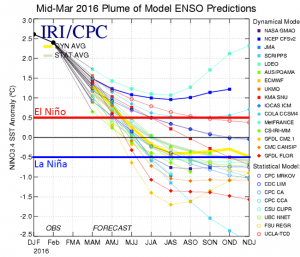La Nina- Weather This Winter
By Michael FaginGeneral Info, Weather ConditionsWith 0 commentsIs La Nina coming this winter? The cyclical phenomenon, signified by cooler temperatures in the mid-Pacific Ocean, may be heading toward its next destination in its continual exchange of heat between the poles and the equator. La Nina can usually occur after a strong El Nino which is what we had last winter.
Over the past several seasons, we were in a major El Nino event that rivaled the historic 1998 event. Interestingly NASA noticed a correlation between the sea surface height anomalies during both events in that both corresponded with a large positive anomaly north of the equator.
The El Nino Southern Oscillation (ENSO) is mapped into regions titled 1+2, 3, 3.4 and 4 to describe the east-to-west positioning of the temperature anomaly. The characteristics of these regions are used to gauge the presence and strength of an ENSO event. Every ENSO region but 4 was near average by the end of May due to below average temperatures underneath the mixing layer gradually surfacing, particularly around the easternmost Pacific region where more upwelling occurs.
There hasn’t been a strong La Nina since the 1988-89 chill. This decade’s appearances were the more moderate event in 2010-11 followed by the weaker event in 2011-12.
What does heightened or diminished severity during a La Nina event do to the States? It doesn’t affect all locations linearly or directly intuitively. For instance, the Pacific Northwest typically sees more rain when the strength is only moderate. On the contrary, the southeastern Midwest has received much less precipitation during moderate La Nina events than during weak or strong. The patterns seen are due to the mechanisms related to casting ashore and dividing atmospheric currents, which change with the sea surface temperatures in the mid-Pacific.
This Winter Forecast
The National Climate Prediction Center is predicting a 75% chance that a weak La Nina will come by fall or winter, with most dynamic models suggesting its arrival in the Northern Hemisphere late this summer. Its next ENSO prediction is coming soon, on the 14th.

Courtesy of NOAA/CPC, IRI, Columbia University. La Nina
Article written by Meteorologist Geoff Linsley
